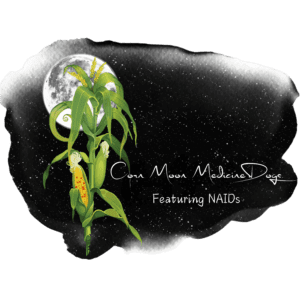Understanding the Three ‘Indian Dog’ Breeds
When researching the Native American Indian Dog (NAID), you’ve probably come across similar-sounding breeds: the North American Indian Dog (NorthAID) and the American Indian Dog (AID). These names get used interchangeably online—but they shouldn’t be.
These are three completely distinct breeds, developed by three different people, for three different purposes—and they are not the same.
Let’s break down the facts to help you understand the history, the intent, and the key differences between these dogs so you can make an informed decision.
Quick Comparison Chart
| Breed | NAID | NorthAID | AID |
| Full Name | Native American Indian Dog | North American Indian Dog | American Indian Dog |
| Founder | Karen Markel | Mark Klemperer | Kim LaFlamme |
| Purpose | Preserve an ancient dog type for companionship and versatility | Create a domesticated wolfdog | Preserve an original line of Indigenous village dogs |
| Wolf Content | No recent wolf content in responsibly bred (preservation) lines | Most are mid to high wolf content | None |
| Registry | NAIDPP (Preservation Project) | CKC (Continental Kennel Club) | IIDOBA |
| Legal Classification | Domestic dog | Often classified as a wolfdog | Domestic dog |
| Genetic Testing | UC Davis + Ancestry Know Your Pet DNA (no wolf content) | Often tests positive for gray wolf DNA | Genetically recognized by most direct-to-consumer DNA tests: Embark, Wisdom Panel |
| Typical Appearance | Tall, medium or long-coated, expressive, human-focused | Strong wolf-like features, mask, and gait | Short coat, medium body type, primitive appearance |
NAID: Native American Indian Dog
The NAID was developed by Karen Markel with the goal of preserving and restoring the dogs similar to the tribal dogs once kept by Indigenous communities across North America. The intention was never to create a wolfdog, but a trainable, intuitive, spiritual companion animal.
While some foundation dogs decades ago included low-content wolfdogs, preservation breeders have removed wolf content through selective breeding. Today, NAIDs from ethical programs test negative for recent wolf ancestry when tested through UC Davis and Know Your Pet DNA.
🧬 The NAIDPP is the only registry working to genetically define and preserve the NAID as a distinct breed with clean ancestry and a defined purpose.
NorthAID: North American Indian Dog
This breed was created by Mark Klemperer, who intentionally bred for ongoing wolf content. NorthAIDs are designed to be domesticated wolfdogs, retaining wolf-like behavior and appearance. They are registered through the Continental Kennel Club (CKC) and often test positive for gray wolf DNA, even several generations in.
The problem? NorthAIDs are often confused as “NAIDs” or “Indian Dogs,” which creates massive misunderstandings and puts owners at risk—especially in states where wolfdogs are illegal.
⚠️ If you live in a restricted state, owning a NorthAID could violate local laws.
AID: American Indian Dog
Developed by Kim La Flamme, the American Indian Dog (AID) is a separate, older line of primitive dogs with a slightly different appearance—often leaner, shorter-coated, and smaller than NAIDs. The AID is said to descend from Indigenous village dogs maintained by La Flamme and others.
AIDs are generally considered domestic dogs and do not contain wolf content, but they are not genetically equivalent to NAIDs or NorthAIDs. They are registered through the International Indian Dog Owners and Breeders Association (IIDOBA).
🌿 While some confusion remains between the AID and NAID, they are not the same breed and have different breed standards and histories.
Why the Confusion?
Let’s be honest: these names are incredibly similar. They all evoke Indigenous history, use the phrase “Indian Dog,” and sometimes even resemble one another in appearance. But the most significant confusion happens between the NAID and NorthAID, and here’s why:
- Some breeders of NorthAIDs market their dogs as NAIDs
- Online articles don’t clarify the difference
- Social media groups actively conflate the two
- These groups promote the idea that NAIDs are wolfdogs—which is not true of legitimate, preservation-bred NAIDs
✅ The NAIDPP is working to correct this misinformation through genetic testing, education, and public outreach—so that puppy buyers know what they’re really getting.
How to Tell Them Apart
| Feature | NAID | NorthAID | AID |
| Temperament | Calm, people-oriented, ideal family dog | Shy, independent, high prey drive | Varies; often primitive, alert, and intelligent |
| Behavior with Strangers | Friendly or aloof, rarely aggressive | Often timid or reactive | Aloof but stable if socialized |
| Laws & Restrictions | Legally a domestic dog | Often banned as a wolfdog | Legally a domestic dog |
| Size & Coat | Medium to large body, medium to long, luxurious coat | Wolf-like, thick mask, lean body | Short coat, more fox-like ears and tail carriage |
Final Thoughts
The world of “Indian Dogs” is filled with overlapping names, varied breeding programs, and passionate opinions. But here’s the bottom line:
- If you want a domestic, spiritually rich, emotionally intelligent dog—choose a NAID from a preservation program that has verified its genetics.
- If you want a dog with wolf content, understand the legal and behavioral implications of a NorthAID.
- If you’re drawn to primitive breeds with unique temperaments, look into the AID, but understand its distinction from the NAID.
Don’t rely on names alone. Rely on testing, purpose, temperament, and transparency.

